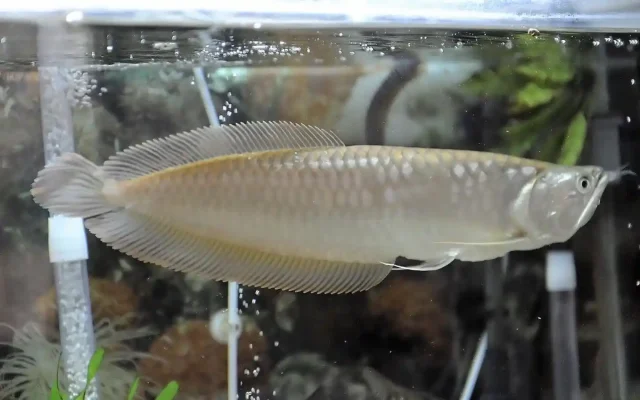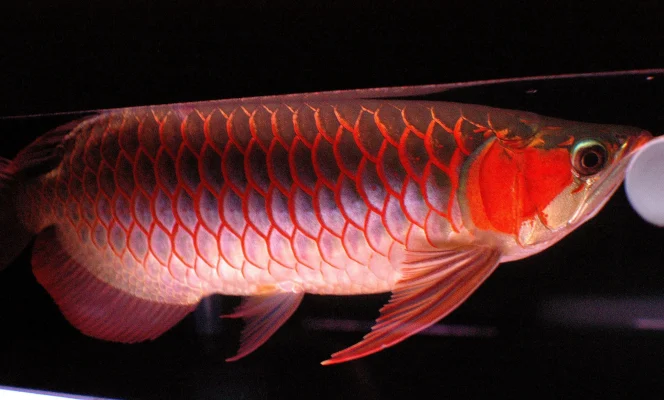How to Identify Different Arowana Varieties: A Beginner’s Guide
How to Identify Arowana Varieties: 2024 Beginner’s Guide
Did you know that some Arowana species can sell for over $300,000, making them among the most expensive aquarium fish in the world? These fascinating creatures, often called “dragon fish,” have captivated aquarists and collectors for decades. But with such high stakes, how can you tell one variety from another? Whether you’re a curious beginner or an aspiring collector, this comprehensive guide will help you navigate the intricate world of Arowana identification.
Understanding Arowana Basics
What are Arowanas and why are they so popular?
Arowanas, members of the ancient fish family Osteoglossidae, are renowned for their distinctive appearance and cultural significance. These elongated, freshwater fish are often referred to as “dragon fish” due to their resemblance to Chinese dragons, with their large scales and long, whisker-like barbels. Asian arowana fish

Their popularity stems from:
- Striking appearance
- Longevity (can live up to 50 years)
- Cultural significance (considered lucky in some Asian cultures)
- Rarity of certain varieties
Overview of Arowana taxonomy and classification
Arowana species belong to the following taxonomic hierarchy:
- Kingdom: Animalia
- Phylum: Chordata
- Class: Actinopterygii
- Order: Osteoglossiformes
- Family: Osteoglossidae
- Genus: Scleropages and Osteoglossum
The most commonly kept Arowana varieties fall under two genera:
- Scleropages (Asian and Australian Arowanas)
- Osteoglossum (South American Arowanas)
Common characteristics shared by all Arowana varieties

Despite their variations, all Arowana species share certain traits:
- Elongated body shape
- Large scales
- Upward-facing mouth
- Barbels on the lower jaw
- Ability to jump out of water
- Carnivorous diet
Key Features for Identifying Arowanas
Body shape and size differences among varieties
While all Arowanas have an elongated body, subtle differences exist:
- Asian Arowana (Scleropages formosus): More compressed body, can grow up to 90 cm
- Silver Arowana (Osteoglossum bicirrhosum): Slender body, can reach 1 meter in length
- Black Arowana (Osteoglossum ferreirai): Similar to Silver Arowana but with a darker coloration
- Australian Arowana (Scleropages jardinii and S. leichardti): Stockier build, typically smaller than Asian varieties
Fin structure and placement
Pay attention to these fin characteristics:
- Dorsal and anal fins: Located far back on the body
- Pectoral fins: Large and wing-like
- Caudal fin: Rounded in most species
Asian Arowanas typically have longer fins compared to their South American counterparts.
Scale patterns and textures
Arowana scale patterns are crucial for identification:
- Large, distinctive scales arranged in a mosaic pattern.
- Asian Arowana: Often have metallic scales with a reflective quality.
- Silver and Black Arowana: Non-metallic scales with a more matte appearance.
- Australian Arowana: Scales can vary from matte to slightly metallic.
Head and mouth shape variations
- Asian Arowana: Concave forehead profile.
- Silver and Black Arowana: More streamlined head shape.
- All varieties have an upturned mouth, but the angle can vary slightly between species.
Body Shape and Size Differences Among Varieties
- Asian Arowana: Slender and elongated.
- Silver Arowana: Extremely elongated with a more streamlined profile.
- Black Arowana: Similar to Silver Arowana but slightly bulkier.
Fin Structure and Placement
- Asian Arowana: Long pectoral and pelvic fins.
- Silver Arowana: Long dorsal and anal fins running parallel to the body.

Scale Patterns and Textures
- Asian Arowana: Large, distinct, and shiny scales.
- Silver Arowana: Smaller, more numerous scales with a metallic sheen.
Head and Mouth Shape Variations
- Asian Arowana: Broad, flat head with a pronounced lower jaw.
- Silver Arowana: Narrower head with less pronounced jaw.
Popular Arowana Varieties and Their Distinctive Traits.
Asian Arowana (Scleropages formosus)
- Golden Arowana. Golden Arowana are known for their vibrant, metallic gold scales. This variety is highly prized and often considered the pinnacle of beauty among Arowanas.
-
- Vibrant gold coloration
- Highly prized in Asian cultures
- Can develop a deep, rich gold with age

- Red Arowana. The Red Arowana boasts scales that range from deep red to orange. Their color intensifies with age and proper diet.
-
- Range from orange to deep red
- Often considered the most valuable color morph
- May have a “blood-red” appearance in high-grade specimens

- Green Arowana. Green Arowanas have a subtler appearance with a greenish hue. They are less vibrant than their red and golden counterparts but equally captivating.
-
- Can range from light to dark green.
- Often have a metallic sheen.
- Some develop blue or purple hues with age.
- Silver Arowana (Osteoglossum bicirrhosum). Silver Arowanas are distinguished by their sleek, silver bodies and long, flowing fins. They are the largest of all Arowana varieties, often reaching up to 4 feet in length. Baby Arowana
- Native to South America
- Silvery-gray coloration
- Large scales with a subtle rainbow sheen
- More affordable and commonly available in the aquarium trade.

Black Arowana (Osteoglossum ferreirai) . Black Arowanas are similar in shape to Silver Arowanas but have a darker, almost black coloration during their juvenile stages, which fades as they mature.
- Also native to South America
- Dark gray to black coloration
- Often confused with Silver Arowana when young
- Rarer in the aquarium trade
Australian Arowana (Scleropages jardinii and S. leichardti) . These Arowanas are known for their hardy nature and unique spotted patterns. S. jardinii typically has more distinct, pearl-like spots compared to S. leichardti.
- Native to Australia and New Guinea
- Golden to olive-green coloration
- Often have dark spots on their scales
- Less common in the international aquarium trade due to export restrictions
Color Variations and Patterns
Understanding base colors vs. color morphs
Base colors are the natural colors of wild Arowana species, while color morphs are variations that have been selectively bred or occur naturally in small populations:
- Base colors: Silver, green, gold
- Color morphs: Red, blue, purple, platinum
Metallic and non-metallic scales
- Metallic scales: Typically seen in Asian Arowana varieties, giving a reflective, shimmering appearance
- Non-metallic scales: More common in South American and Australian varieties, with a matte finish
Unique patterns and markings
- Crossback Arowana: Distinctive pattern where the dark coloration on the back extends down the sides in a cross-like pattern
- Red-tailed golden Arowana: Golden body with red fins, highly prized
- Spot patterns: Some varieties, especially Australian Arowanas, may have distinctive spot patterns on their scales.

How lighting affects color perception
Lighting plays a crucial role in Arowana color variations:
- Natural sunlight often brings out the true colors
- Fluorescent lighting can enhance blue and green hues
- LED lighting can be adjusted to highlight specific color traits
Pro tip: When identifying Arowanas, always observe them under different lighting conditions to get a true sense of their coloration.
Age and Size Considerations in Identification
How Arowana appearance changes with age
Arowana age differences can significantly affect their appearance:
- Juvenile Arowanas often have less vibrant colors
- Adult Arowanas develop fuller, more rounded bodies
- Color intensity and pattern clarity often improve with age
Size differences between varieties
|
Arowana Variety |
Average Adult Size |
|
Asian Arowana |
60-90 cm |
|
Silver Arowana |
75-100 cm |
|
Black Arowana |
90-120 cm |
|
Australian Arowana |
60-90 cm |
Growth rates and maximum sizes
- Arowana growth rate: Can grow up to 2-3 cm per month in optimal conditions
- Arowana maximum size: Varies by species, with some reaching over 1 meter in length
- Environmental factors like tank size and diet can affect growth rates
Common Mistakes in Arowana Identification
Look-alike species and how to differentiate them
- Silver Arowana vs. Black Arowana:
- Look for subtle color differences and fin shapes
- Black Arowanas have a darker base color, even as juveniles
- Asian Arowana color morphs:
- Green and golden varieties can be confused
- Observe under different lighting conditions
Factors that can alter Arowana appearance
- Diet: Poor nutrition can lead to dull colors
- Stress: Can cause color fading or unusual patterns
- Water quality: Affects scale and fin health
The importance of reputable sources and expert opinions
Always consult:
- Certified Arowana breeders
- Experienced aquarists
- Scientific literature on Osteoglossidae
Tools and Resources for Arowana Identification
Recommended guidebooks and online resources
Recommended Guidebooks and Online Resources
- “Arowana: A Layman’s Guide” by Dr. Yeo Boon Kiat
- “Arowana Enthusiast Magazine” online edition
- Online databases like Seriously Fish and FishBase
Importance of high-quality photographs for identification
- Use high-resolution cameras
- Capture multiple angles
- Ensure proper lighting to showcase true colors
Joining Arowana enthusiast communities for expert advice
- Online forums like Monster Fish Keepers
- Local aquarium clubs
- Social media groups dedicated to Arowana keeping
Conclusion: And there you have it, folks – your crash course in Arowana identification! Remember, becoming an expert takes time and practice, but with this guide, you’re well on your way to distinguishing a Golden Arowana from a Silver Arowana like a pro. As you continue your Arowana journey, don’t forget to appreciate these magnificent creatures for more than just their appearance or value. They’re living, breathing marvels of nature with personalities as unique as their scales! So, whether you’re planning to keep Arowanas or simply admire them from afar, keep learning, stay curious, and most importantly – have fun exploring the incredible world of Arowanas!
Key Takeaways:
- Understand basic Arowana anatomy and taxonomy
- Learn to identify key features like body shape, fin structure, and scale patterns
- Familiarize yourself with popular varieties and their distinctive traits
- Consider age and size when identifying Arowanas
- Be aware of common identification mistakes and factors that can alter appearance
- Utilize reliable resources and expert opinions for accurate identification.
FAQs
What is the difference between Asian Arowana and Silver Arowana?
- Asian Arowanas are typically smaller with more vibrant, metallic colors, while Silver Arowanas are larger and have a sleek silver body.
How can I enhance the color of my Arowana?
- Providing a diet rich in carotenoids and ensuring proper lighting can enhance your Arowana’s natural colors.
What is the lifespan of an Arowana?
- Arowanas can live for 10 to 15 years with proper care, although some have been known to live up to 20 years.
Can different Arowana varieties be kept together?
- Mixing different Arowana varieties can lead to aggression, as they are territorial fish. It’s generally advised to keep them in separate tanks.
What are the legal considerations for owning an Arowana?
- Some countries, like the United States, have restrictions on owning certain Arowana species due to their endangered status. Always check local regulations.
How do I determine the sex of my Arowana?
- Sexing Arowanas can be challenging. Typically, males have broader heads and longer fins, but genetic testing is the most accurate method.
What size tank is suitable for an Arowana?
Arowanas require large tanks, with a minimum of 250 gallons for most varieties to ensure they have ample space to swim.
Read more.
Jardini Arowana for Sale in USA


 Deutsch
Deutsch